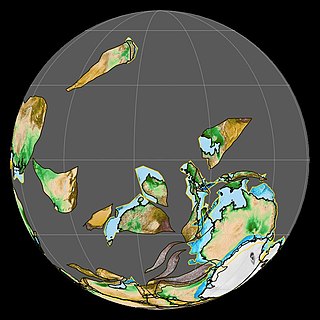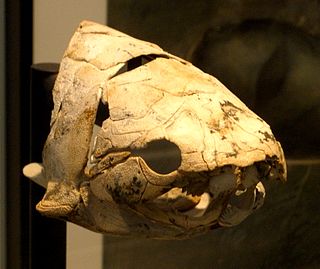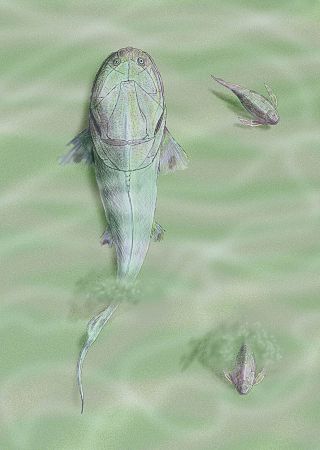
The Devonian is a geologic period and system of the Paleozoic era during the Phanerozoic eon, spanning 60.3 million years from the end of the preceding Silurian period at 419.2 million years ago (Ma), to the beginning of the succeeding Carboniferous period at 358.9 Ma. It is named after Devon, South West England, where rocks from this period were first studied.

Lungfish are freshwater vertebrates belonging to the class Dipnoi. Lungfish are best known for retaining ancestral characteristics within the Osteichthyes, including the ability to breathe air, and ancestral structures within Sarcopterygii, including the presence of lobed fins with a well-developed internal skeleton. Lungfish represent the closest living relatives of the tetrapods. The mouths of lungfish typically bear tooth plates, which are used to crush hard shelled organisms.

The Australian lungfish, also known as the Queensland lungfish, Burnett salmon and barramunda, is the only surviving member of the family Neoceratodontidae. It is one of only six extant lungfish species in the world. Endemic to Australia, the Neoceratodontidae are an ancient family belonging to the class Sarcopterygii, or lobe-finned fishes.

Placodermi is a class of armoured prehistoric fish, known from fossils, which lived from the Silurian to the end of the Devonian period. Their head and thorax were covered by articulated armoured plates and the rest of the body was scaled or naked, depending on the species. Placoderms were among the first jawed fish; their jaws likely evolved from the first of their gill arches.

Dorothy Hill, was an Australian geologist and palaeontologist, the first female professor at an Australian university, and the first female president of the Australian Academy of Science.

The Pituriaspida are a small group of extinct armored jawless fishes with tremendous nose-like rostrums, which lived in the marine, deltaic environments of Middle Devonian Australia. They are known only by two species, Pituriaspis doylei and Neeyambaspis enigmatica found in a single sandstone location of the Georgina Basin, in Western Queensland, Australia.

The Tournaisian is in the ICS geologic timescale the lowest stage or oldest age of the Mississippian, the oldest subsystem of the Carboniferous. The Tournaisian age lasted from 358.9 Ma to 346.7 Ma. It is preceded by the Famennian and is followed by the Viséan. In global stratigraphy, the Tournaisian contains two substages: the Hastarian and Ivorian. These two substages were originally designated as European regional stages.

The geology of Australia includes virtually all known rock types, spanning a geological time period of over 3.8 billion years, including some of the oldest rocks on earth. Australia is a continent situated on the Indo-Australian Plate.

A fossil track or ichnite is a fossilized footprint. This is a type of trace fossil. A fossil trackway is a sequence of fossil tracks left by a single organism. Over the years, many ichnites have been found, around the world, giving important clues about the behaviour of the animals that made them. For instance, multiple ichnites of a single species, close together, suggest 'herd' or 'pack' behaviour of that species.

Pituriaspis doylei is one of two known species of jawless fish belonging to the Class Pituriaspida, and is the better known of the two. The species lived in estuaries during the Givetian epoch of the Middle Devonian, 390 million years ago in what is now the Georgina Basin of Western Queensland, Australia.

Phyllolepis is the type genus of Phyllolepida, an extinct taxon of arthrodire placoderm fish from the middle to late Devonian. The species of Phyllolepis, themselves, are restricted to the Famennian-aged freshwater strata of the Late Devonian, around 360 million years ago. Fossils of this genus have been found primarily in Europe and North America. The end of the Devonian saw them disappear in a mass extinction.
Luckeus is an extinct genus of prehistoric lobe-finned fish. Luckeus belonged to the order Onychodontida. It lived during the Early Devonian to Middle Devonian period in what os now central Australia.
Gavinaspis is a phyllolepid placoderm which lived during the Early Devonian period, of Qujing, Yunnan province, south China.

Eastmanosteus is a fossil genus of dunkleosteid placoderms. It was closely related to the giant Dunkleosteus, but differed from that genus in size, in possessing a distinctive tuberculated bone ornament, a differently shaped nuchal plate and a more zig-zagging course of the sutures of the skull roof.

Wuttagoonaspis is an extinct genus of primitive arthrodire placoderm fish from the Middle Devonian of Australia. The box-like skull is up to 18 centimeters in length, and the median dorsal plate averages in length about 10 centimeters. It contains two species: the type species Wuttagoonaspis fletcheri, described by Ritchie in 1973, and Wuttagoonaspis milligani, described by Young and Goujet in 2003.

Homostiidae is a family of flattened arthrodire placoderms from the Early to Middle Devonian. Fossils appear in various strata in Europe, Russia, Morocco, Australia, Canada and Greenland.

Serenichthys kowiensis is a fossil species of coelacanth described in 2015 from near Grahamstown in South Africa.

Antarctilamna is an extinct genus of Devonian cartilaginous fish originally exemplified by Antarctilamna prisca from South Eastern Australia and Antarctica. The latest occurring described species is Antarctilamna ultima from the Waterloo Farm lagerstätte in South Africa. Antarctilamna has robust ctenacanthid-like spines which lack a deep insertion area, and are borne in front of the first dorsal fin; in addition to distinctive diplodont teeth with small intermediate cusps. Antarctilamna-like spines, known from the Bunga Beds locality in Australia have been ascribed to A. prisca.

Migmatocephala is a clade of placoderm fish within the suborder Brachythoraci. Migmatocephala includes the homostiids Taemasosteus?, Tityosteus, Antineosteus, Atlantidosteus, and Homosteus.






















